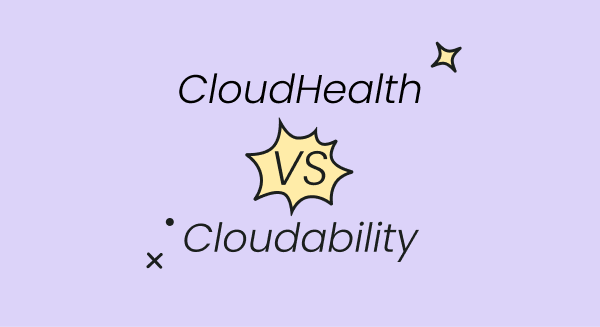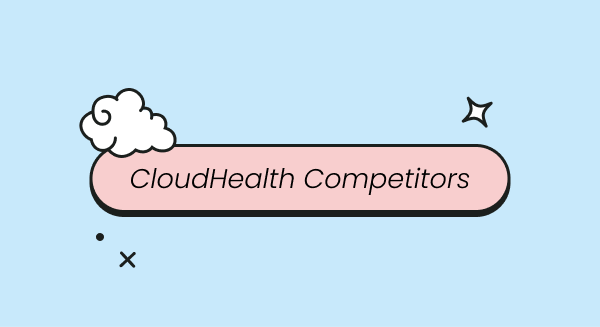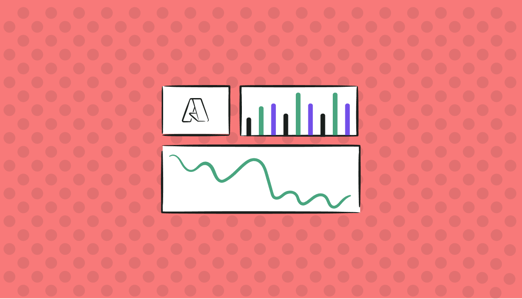
Azure Kubernetes Service Pricing: Cost Optimization and Management
Azure Kubernetes Service (AKS) simplifies the process of deploying a managed Kubernetes cluster by allowing Azure to take care of essential operational tasks such as monitoring and maintenance. AKS also integrates seamlessly with other Azure services, such as Azure Container Registry and Azure Monitor.
While AKS provides many benefits, pricing is one of the most important considerations when using it. According to a 2022 State of Cloud Strategy Survey, 94% of respondents confessed to overspending and wasting money on their cloud investments. Understanding how AKS pricing works and how to choose the right plan can save you money and help you avoid unexpected costs.
In this blog post, we'll break down the Azure Kubernetes Services pricing and the necessary practices to extract the most value from your investment.
Understanding AKS Pricing Models
AKS offers a variety of pricing models to choose from, each with its advantages and disadvantages. Familiarizing yourself with the different models and how they function will make it easier to select an appropriate plan for your business.
The pricing structure of AKS is relatively straightforward – there’s no initial set-up cost or termination fee. It provides a completely free management of Kubernetes clusters with no additional charges. As a result, you only pay for nodes that AKS uses to build containers. The same goes for cloud resources, like VMs, storage, and networks. This makes it one of the market's most cost-effective and competitive container orchestration services.
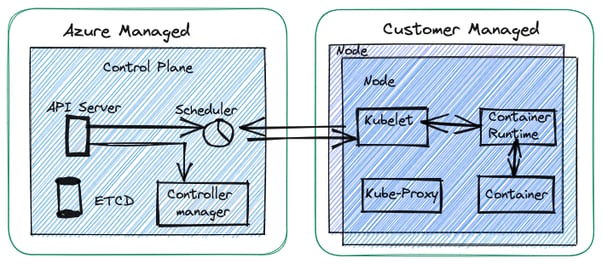
Reference: Microsoft
Hence, using AKS gives you access to paid Azure services and tools, such as Azure DevOps, Azure Active Directory, and more. That way, you can better monitor and manage your containerized infrastructure costs.
Azure services vary in cost based on their type, location, payment plan, and usage. And besides that, AKS offers several pricing modes to meet the needs of different use cases. The most common pricing modes are:
Free Tier
Azure offers a free tier with basic services, and a $200 credit to try any other paid service. Also included in the free plan is a limited usage limit for other Azure services such as Azure Storage, Azure Container Registry, and Azure Arc.
This pricing plan caters to organizations and developers who wish to evaluate AKS in small development scenarios. Note that while usage of these services is free, there may still be charges for other resources, such as data transfer and storage.
Despite these limitations, the free pricing plan can be an excellent option for users who are just starting with AKS and want to try it out before committing to a paid plan.
Pay-As-You-Go ( PAYG)
Pay-As-You-Go (PAYG) is a pricing option for Azure services, including Azure Kubernetes Service (AKS).
In this model, you only have to pay for the resources you use, with no upfront cost or commitment required. There are many benefits to using this option, especially if you have have variable or unpredictable workloads, as you only pay for the resources you use.
For instance, if an EKS node provisions a VM instance, you'll pay for that VM each month for the duration of that allocation. You only stop paying for that resource once it's terminated.
Besides that, you also get an SLA with a 99.95% availability for the Kubernetes API server using Azure Availability Zones, or 99.9% for clusters without one.
This pricing option can be helpful for customers who have a lower budget or are unsure of the resources they will need in the future. This is also an excellent starting point for customers who are new to AKS and want to evaluate the service before committing to a longer-term contract.
Azure Hybrid Benefit
Azure Hybrid Benefit is a cost-saving benefit that enables current on-premises users with active Software Assurance or subscription for Windows Server and SQL Server licenses to use them on Azure.
With AHB, you can use existing licenses to pay a reduced rate for VMs running Windows Server or SQL Server, therefore saving you money on your AKS clusters since many AKS clusters operate on these VMs.
Organizations can save up to 85% compared to standard pay-as-you-go rates and achieve the lowest cost of ownership when combined with reservation pricing and extended security benefits.
This pricing model applies directly to Azure's underlying infrastructure and not specifically to AKS. For Azure Hybrid to work with AKS, you must use the Azure Virtual Machine option.
Azure Reserved Pricing
Azure Reserved Pricing is another option you can apply to AKS to save cost by committing to one- or three-year terms. With this model, you can pay a discounted upfront price for the resources you need, such as VMs and storage, and continue to pay lower rates for those resources throughout your reserved term.
Customers who can commit to a longer-term usage of AKS and have a predictable or steady workload can benefit from this pricing model.
For example, if you know you'll need a certain number of VMs and storage for your AKS cluster for the next three years, you can purchase Azure Reserved Instances for those resources and save up to 72% compared to pay-as-you-go pricing.
Please note that the Azure Reserved Pricing option is only available for the underlying infrastructure and not for AKS itself.
Azure Spot Instances
This pricing model is a cheaper pricing model that takes advantage of spare capacity available by infrastructure providers. Users can bid for Azure resources, including VMs that would otherwise be unused, at a heavily discounted rate.
Azure Spot Instances offer discounted rates for non-critical workloads when used in conjunction with AKS.
This option is more budget-friendly and suitable for users who have flexible workloads and can handle interruptions but not for critical or time-sensitive applications. If your workloads can tolerate interruptions and can be rescheduled quickly on another node, you can take advantage of this feature.
Managing and Monitoring AKS Costs
Like other major cloud providers, Azure offers built-in tools for controlling and optimizing cloud spending. It uses advanced analytics to identify usage patterns that may lead to increased costs and provides recommendations for cost savings. Users can set budgets and receive notifications when they are exceeded, and they can also set notifications for when allocated resources are running low. The cost management services are available at no additional cost for all Azure users.
Here is the list of out-of-the-box tools provided by AKS:
Azure Price Calculator
Azure Price Calculator is a service for estimating the cost of Azure services – you find the service or resource you're interested in, choose the details and settings, and the calculator will provide a detailed real-time breakdown of costs for the service based on selected criteria.
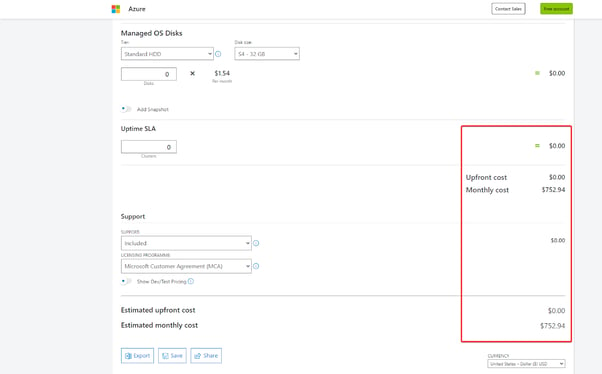
Image: Price Calculator Example
Microsoft Cost Management
Azure also offers a highly capable & complimentary solution to manage and optimize Azure costs known as Microsoft Cost Management. This solution comes with several other tools, such as:
- Azure cost analysis: With this tool, you get a high-level view of your spending, which also includes accumulated costs for the current month, forecast costs over a given period, and the costs associated with particular Azure services or resources.
You can also filter Azure spending by factors such as scope, duration, granularity, and group by the organization, giving you a more detailed picture of spending and consumption.
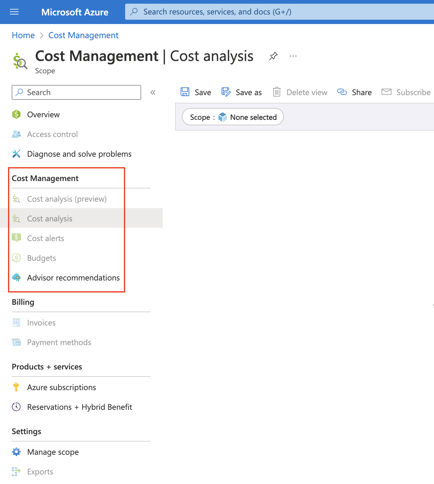
Image: Azure Cost Management Tool
- Azure cost alert: The Azure cost alerts notify you automatically when usage or cost reaches a specified threshold. There are three types of alerts: budget, credit, and quota alerts for each department.
- Azure budgets: By using this tool, businesses can ensure they stick to specific cloud budgets. You can set budgets based on actual or anticipated costs, and Azure alerts you when a threshold is reached or exceeded so you can react before unwanted costs occur.
Read more: Azure Cost Management Tools
Azure Monitor for Containers
Azure Monitor can be used specifically to monitor Azure Kubernetes Services.
It’s designed to monitor the resource usage of each cluster's applications, including CPU, memory, and storage. It also helps to ensure the pod processes are running smoothly and that enough nodes are available to support them by monitoring the Kubernetes cluster and checking for pod container crashes and restarts.
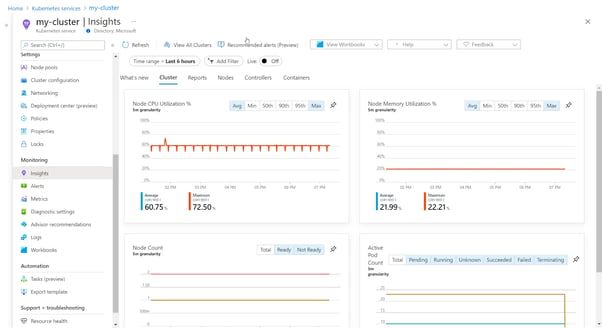
Image: Azure Monitoring
Tips and Tricks for Reducing Azure Kubernetes Service Cost
Identify unused resources
Cloud providers charge fees for all resources purchased, even if they are not used immediately. To cut costs, locate and eliminate these unused resources, including storage and virtual discs.
Optimize Azure Costs with Proper VM Type Selection
You can reduce your Microsoft Azure costs altogether by selecting your workload's appropriate VM type. Azure VMs come in various types, such as General Purpose, Compute Optimized, Memory Optimized, Storage Optimized, and GPU. By understanding the ideal VM type for your workload and monitoring resources, you can optimize expenses and reduce costs.
Pod/Container Rightsizing
You can reduce costs on AKS by ensuring that the resources allocated to each container or pod are optimal for your workload. Start by optimizing container resource allocation using tools like the VPA (Vertical Pod Autoscaler) to adjust requests and limits automatically.
Additionally, reviewing and adjusting the settings in the YAML files that define the pod/container can also help to limit CPU and memory usage, which can go a long way in helping you reduce costs.
Fine-tune Autoscaling
Azure offers dynamic autoscaling options to respond dynamically, but it requires careful planning and configuration adjustments. By properly configuring horizontal pod autoscaling (HPA) and cluster autoscaling, you can minimize waste and reduce costs associated with running your application.
Read more: How to reduce Azure storage costs
Enhance AKS Pricing with a Holistic Cost Monitoring Tool
While native cloud cost tools have many advantages, they can be severely lacking in terms of visibility into which teams, applications, and services utilize specific parts of your containerized infrastructure, such as tracking resource usage to the right cost centers (business units, teams, apps, and/or services) for chargebacks.
A comprehensive cost-monitoring solution like Finout can enhance monitoring and analysis, providing a more comprehensive and granular understanding of usage and costs. Here are the features to look for when selecting a cost-monitoring tool:
Maximum Transparency
When you don't completely understand your Azure charges, you're likely to end up with substantially higher costs. It's possible to have inactive instances that have not been deleted and still get charged for them.
You need monitoring tools capable of providing details such as:
- Usage and Cost Overview: usage and cost information based on teams, features, etc.
- Easy Financial Reporting: Pre-built reports and custom dashboards
- Optimization report: Indicate where resources can be shifted to less costly alternatives, such as cheaper CPU, storage, network, etc.
- Governance reporting: Identify missing resources or incomplete tags, such as application ID, environment type (Prod, Dev, Test), project code, etc.
To effectively manage container costs, you should use a cloud cost optimization platform that is easy to use by everyone, including your finance team, development team, and engineering team. Besides that, you want to have a platform with a robust data engine to collect and analyze containerization and node utilization costs over time.
- Automated Cost Savings
Cloud tools can save you money by automatically stopping or reallocating underutilized resources. Having automated cost savings tools reduces unnecessary spending by helping you make the most of existing resources.
- Granularity
A rogue pod or cluster can run up massive cloud bills if not detected quickly. Having a tool that offers granular data to the smallest unit allows for an almost real-time view of potential problems before they become costly.
- Tag Management
This feature is an important one to look for. For easy categorization of Azure resources, tag management is essential; however, most standard tools provide limited capability with tagging.
- Multi-Cloud Monitoring
A holistic cloud monitoring tool can give you a complete picture of your cloud infrastructure across multiple cloud environments, including Azure, AWS, and GCP. This gives you greater visibility and control over your resources by enabling you to manage and monitor your entire cloud environment.
AKS Pricing Management With Finout
Considering the high cost of cloud resources due to over-provisioning or poor management, you need a more holistic solution. This solution should offer granular data, maximum observability, tag management, and multi-cloud monitoring, which is why you should consider a solution like Finout.
Finout gives you complete granular cost observability into your AKS spend (down to the resource level) but also detects waste, gives RI recommendations, provides efficient tag management, and has a complete view across EKS, GKE, and other cloud environments.
Related Kubernetes content:

